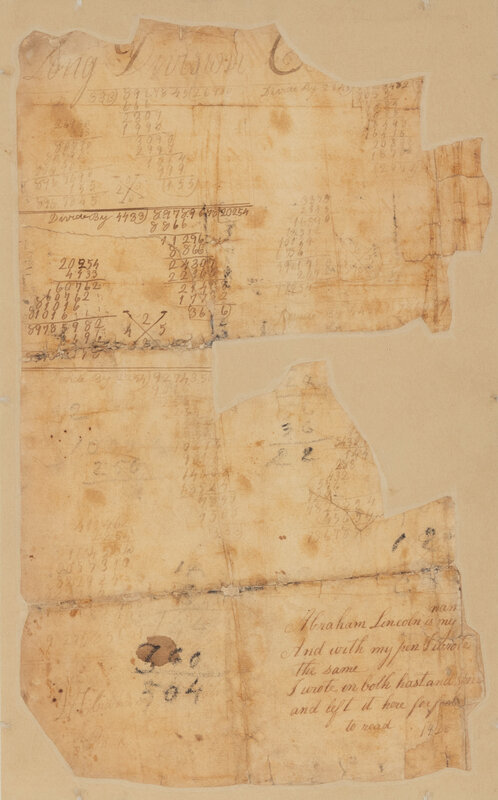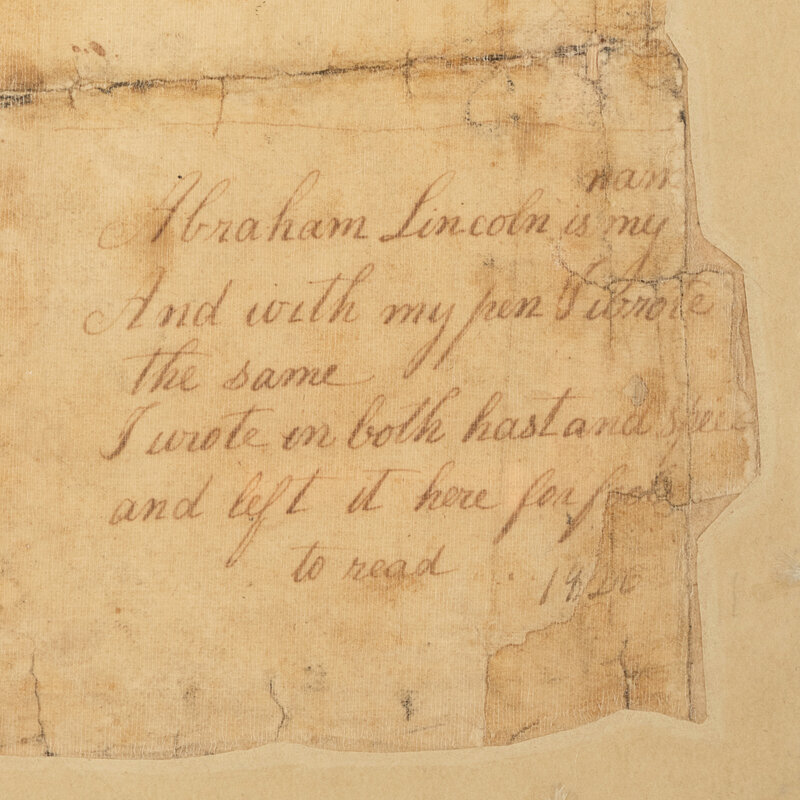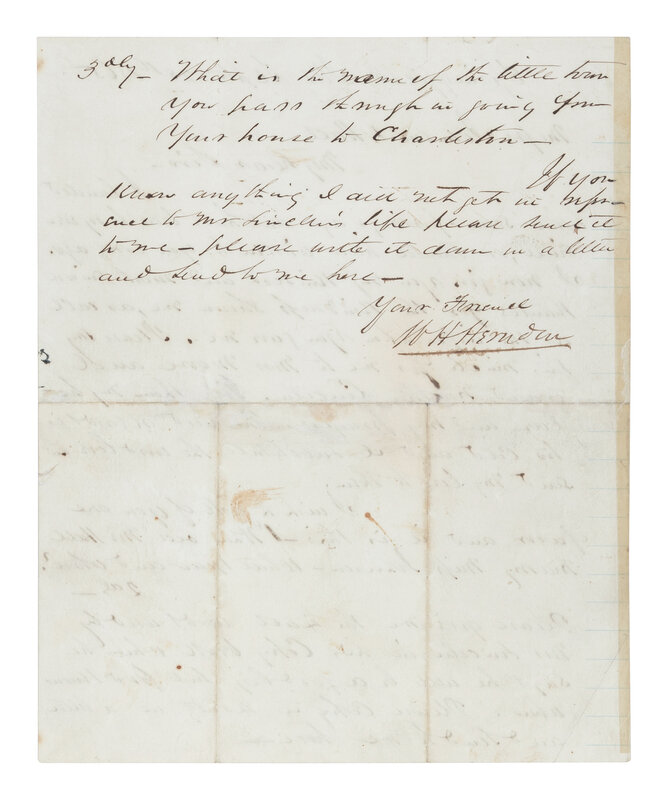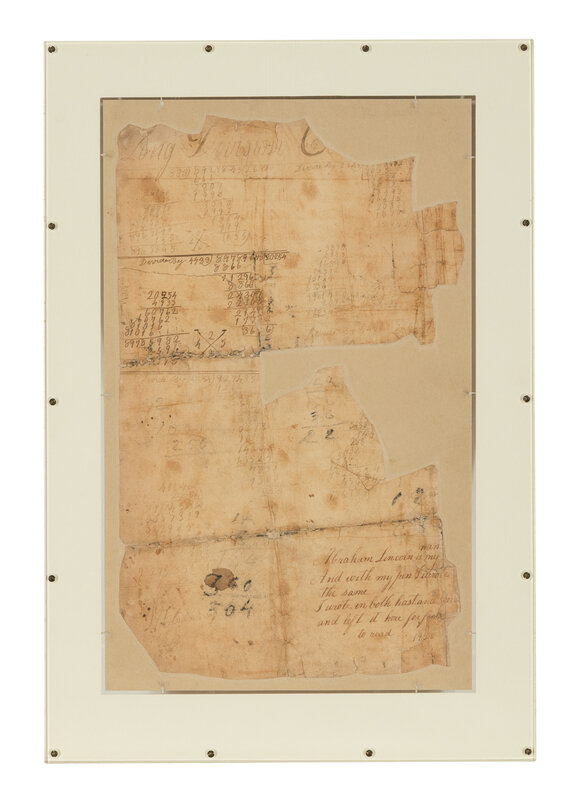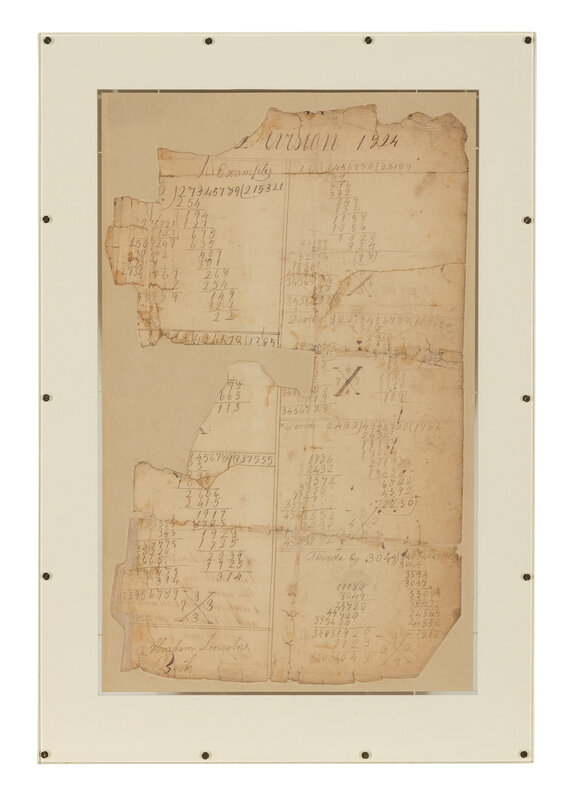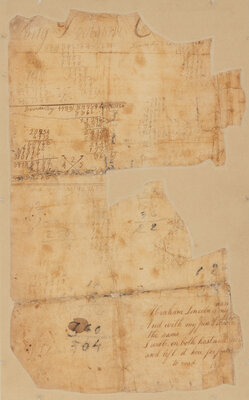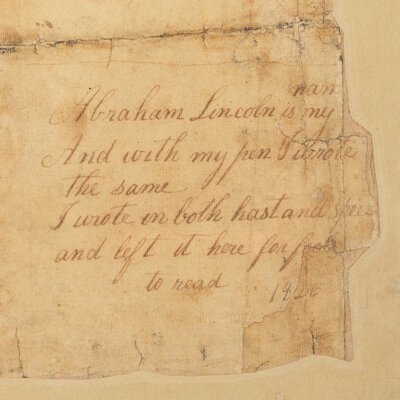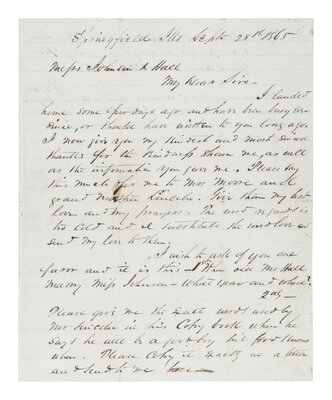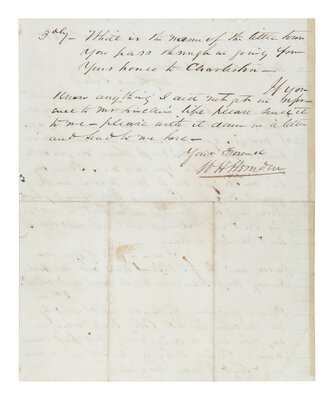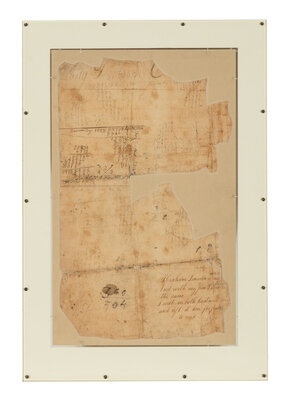Condition Report
Contact Information
Auction Specialist
Lot 2
Sale 6441 - Lincoln’s Legacy: Historic Americana from the Life of Abraham Lincoln
May 21, 2025
10:00AM CT
Live / Chicago
Own a similar item?
Estimate
$300,000 -
400,000
Price Realized
$521,200
Sold prices are inclusive of Buyer’s Premium
Lot Description
LINCOLN, Abraham (1809-1865). Autograph sum book leaf signed twice ("Abraham Lincoln"). Pigeon Creek, Spencer County, Indiana, ca. 1824.
2 pp. (recto and verso); 12 1/4 x 7 1/2 in. (311 x 190 mm). Significant losses professionally reinforced and filled in using archival silk paper, by The Lakeside Press; laid between two sheets of plexiglass; some soiling at extremities; old folds and closed tears repaired or filled in, some spotting; in morocco folding case.
THE EARLIEST SURVIVING EXAMPLE OF ABRAHAM LINCOLN'S HANDWRITING.
"Sum" or "copy" books were used by children, often on the frontier, where proper textbooks were scarce. The present leaf represents not only the earliest known example of Abraham Lincoln's handwriting but also the value that he placed on a proper education from an early age, albeit with a wry sense of humor thrown in. On the verso, tucked in a corner amidst the sums is a short verse which reads, "Abraham Lincoln is my nam[e] / And with my pen I wrote / the same / I wrote in both hast[e] (sic) and speed / And left it here for fools / to read." The other side of the leaf is headed "Long Division" and is filled with Lincoln's calculations of long division problems and their proofs. In one instance, Lincoln divides 3,456,780 by 132, checking his answer of 26,187 (with a remainder of 98) by multiplying it by 132. The page has five further division problems, all similarly divided and proved. It is signed in the lower left corner, "Abraham Lincoln's Book." This leaf is also the first page from Lincoln's sum book, and appears as the first illustration in Roy P. Basler's The Collected Works of Abraham Lincoln. The 11 surviving leaves have since been dispersed, and we are aware of only one other leaf presently in private hands, the last having been discovered in June 2013. Basler I, p. 1.
The importance of education is a key theme in the life of Abraham Lincoln, who was born in a humble log cabin to Thomas and Nancy Hanks Lincoln on 12 February 1809. By the time Lincoln was five years old, his father had lost most of his land in Kentucky in a series of land disputes, which led the family to migrate to Indiana. Two years after their arrival, Lincoln's mother died, and a little over a year later, Thomas Lincoln married his childhood friend Sarah Bush Johnston, a widow with three children of her own. Due to the pressures of helping his father to run the family farm, Lincoln's formal schooling lasted a little less than a year. However, his stepmother encouraged him to further his education by giving him books she'd brought with her from Kentucky.
The bond between Sarah's family and her stepson endured even as that between Lincoln and his father Thomas deteriorated. After helping to move the family from Indiana to Illinois in 1830, Lincoln and his father rarely saw one another, though Lincoln kept in regular contact with his stepmother and step-siblings. So strong was the bond between the two that for the rest of his life Lincoln referred to Sarah as "Mama", and wrote to her often and visited when he could, with their last meeting taking place shortly before Lincoln left for the White House in early 1861. Upon receiving news of his death, she is said to have responded simply, "I knowed they'd kill him. I ben awaitin' fur it."
The sum book Lincoln kept through the collective twelve months of his formal education meant enough to Sarah for her to keep and maintain it through the years. Shortly after his death, Lincoln's former law partner William H. Herndon approached Sarah and inquired about any items of his she might be willing to part with, writing that "She gave me... a few leaves from a book made and bound by Abe, in which he had entered, in a large, bold hand, the tables of weights and measures, and the 'sums' to be worked out in illustration of each table" (Herndon's Lincoln, pp. 40-41).
[With]: HERNDON, William Henry (1818-1891). Autograph letter, signed ("W.H. Herndon") to Messrs. Johnson & Hall. Springfield, 28 September 1865. 1 p.; folds; some very minor soiling.
This letter reads in full: "I landed home some four days ago and have been busy ever since, or should have written to you long ago. I now give you my kindest and most sincere thanks for the kindness shown me, as well as the information you gave me. Please say this much for me to Mr. Moore and Grand mother Lincoln. Give them my best love and my prayers...I wish to ask of you one favor and it is this--1st when did Mr. Hall marry Miss Johnson--what year and where? 2nd--Please give me the exact words used by Mr. Lincoln in his Copy book when he says he will be a good boy but God knows when. Please copy it exactly in a letter and send it to me here--3rdly--What is the name of the little town you pass through in going from your house to Charleston--If you know anything I did not get in before such to Mr. Lincoln's life please send it to me--please write it down in a letter and send to me here--Your Friend WH Herndon".
Provenance:
Sarah Bush Johnston Lincoln
Presented to William H. Herndon (1818-1891), lawyer and law partner of Abraham Lincoln
Justin George Turner (1898-1976), American lawyer, historian, author, and collector of Lincolniana; sold, his sale, Hamilton Galleries, 25 October 1967, lot 6
Sotheby's, New York, 13 June 1991, sale 6188, lot 218A
Louise Taper, Beverly Hills, California
Exhibition:
The Last Best Hope of Earth: Abraham Lincoln and the Promise of America, at the Huntington Library, October 1993-August 1994
Abraham Lincoln: A Personal Journey, at the Gerald Ford Presidential Museum, 12 October 2001-18 February 2002
Property from the Abraham Lincoln Presidential Foundation
